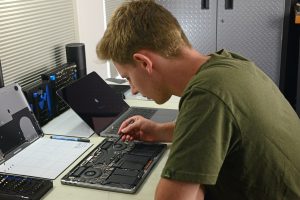Advancements in Apple Repair Technologies: Wholesale Solutions

Apple is one of the world’s premier and most innovative technology companies, producing top-tier electronics. Globally, millions of individuals trust the company’s devices with their data, work, and entertainment needs.
However, as with any technology, Apple devices are susceptible to malfunctions, and a distinct industry has emerged dedicated to repairing Apple technology. This article’ll explore the solutions available to service centers striving to deliver quality and timely customer service. We’ll also delve into the future prospects in the realm of Apple replacement parts.

Evolution of Apple Product Service
Apple has always set out to create distinctive products that stand apart in terms of design, functionality, and performance. This dedication to innovation has, in turn, made repairing and servicing these devices a more intricate task, demanding specialized knowledge, tools, and components.
To address this, Apple initiated the Apple Authorized Service Provider (AASP) program, granting select companies official authorization to repair Apple products. However, this program’s coverage was not universal and came with stringent requirements and limitations imposed by Apple. As a result, many service centers started exploring alternative methods for repairing Apple products, leading to the rise of the independent repair industry.
Challenges in Apple Repair
Apple products are renowned for their quality and reliability, but this doesn’t necessarily translate to straightforward repair and maintenance. Some of the most common challenges faced by service providers include:
- Difficulty of Repair: Apple devices have intricate designs that make it difficult to access internal components. For instance, some iPhone models require specialized screwdrivers for disassembly. Moreover, certain parts, such as screens, batteries, or cameras, are attached to the device’s casing or other components, complicating replacements. Additionally, replacing Apple components can be expensive and time-consuming.
- Conflict with Apple’s Policies: Apple does not endorse the activities of independent service centers and seeks to limit their capabilities in repairing Apple products. For instance, the company utilizes microchips and software to block a device or specific functions upon detecting component replacement through unofficial channels. Furthermore, Apple may deny warranty service or device updates if it learns that a device has been repaired outside of AASP. Sometimes, Apple even takes legal action against service centers or parts suppliers for copyright or trademark infringement.
The Self-Repair program has made Apple product repair more accessible, but challenges remain for service centers. To succeed in this field, professionals must demonstrate high competence, ethics, and professionalism. However, investing in new Apple repair technologies and offering wholesale solutions can create new entrepreneurial opportunities.
Wholesale Solutions for Service Centers
Service centers require access to high-quality and dependable spare parts, tools, and equipment to repair Apple products effectively. Nevertheless, not all suppliers can provide such solutions at wholesale prices with quality assurance. Several criteria can aid in the evaluation of parts and equipment suppliers for Apple product repair:
- Variety: Suppliers should offer a comprehensive range of components and equipment catering to various Apple device models and generations. This enables service centers to handle new and older devices and undertake a diverse array of repairs, from simple to complex.
- Quality Assurance: Suppliers must guarantee the quality of their products, ensuring they align with the original specifications. Furthermore, services should come with warranties and offer options for returns or exchanges in case of defects or non-compliance.
- Efficient Delivery: Suppliers should provide prompt and convenient delivery of their products to any location, domestic or international. They should also furnish a tracking number for monitoring delivery status and insurance in case of loss or damage during transit.
- Customer Support: Suppliers should maintain a professional and responsive customer support service capable of promptly and adeptly addressing all client inquiries and issues.
When selecting wholesale solutions for service centers that repair Apple products, it is imperative to consider all factors affecting the quality, speed, and cost of repairs. This is the only way to ensure high service and customer satisfaction.
The Future of Apple Repair Technologies
Apple product repair technologies are poised for continual evolution and adaptation to meet new demands and possibilities. In the future, several directions for the development of Apple repair technologies can be anticipated:
- Tools for Repairing Complex Apple Devices: As Apple devices become more complex and compact, advanced tools and equipment will be needed for repairs. These tools will include microscopes, soldering irons, oscilloscopes, and other specialized instruments to work with microscopic elements on the motherboard. Specialized devices for testing and diagnosing Apple devices will also be necessary to identify malfunctions and recommend optimal repair methods.
- AI and ML Integration: AI and ML can improve the quality and efficiency of Apple product repairs. Neural networks analyze repair data and predict breakdowns, recommending optimal repair solutions.
These avenues of development in Apple repair technologies promise to create new possibilities for service centers committed to delivering the best service to their customers.




